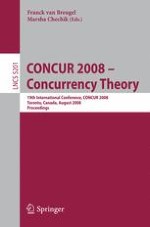This volume contains the proceedings of the 19th International Conference on Concurrency Theory (CONCUR 2008) which took place at the University of TorontoinToronto,Canada,August19–22,2008. CONCUR2008wasco-located with the 27th Annual ACM SIGACT-SIGOPS Symposium on the Principles of Distributed Computing (PODC 2008), and the two conferences shared two invited speakers, some social events, and a symposium celebrating the lifelong research contributions of Nancy Lynch. The purpose of the CONCUR conferences is to bring together researchers, developers, and students in order to advance the theory of concurrency and promote its applications. Interest in this topic is continuously growing, as a consequence of the importance and ubiquity of concurrent systems and their applications, and of the scienti?c relevance of their foundations. Topics include basic models of concurrency (such as abstract machines, domain theoretic m- els, game theoretic models, process algebras, and Petri nets), logics for c- currency (such as modal logics, temporal logics and resource logics), models of specialized systems (such as biology-inspired systems, circuits, hybrid systems, mobile systems, multi-core processors, probabilistic systems, real-time systems, synchronoussystems, and Web services),veri?cationand analysis techniques for concurrent systems (such as abstract interpretation, atomicity checking, mod- checking, race detection, run-time veri?cation, state-space exploration, static analysis,synthesis,testing, theorem provingand type systems), andrelated p- gramming models (such as distributed or object-oriented). Of the 120 regular and 5 tool papers submitted this year, 33 regular and 2 tool papers were accepted for presentation and areincluded in the present v- ume.
